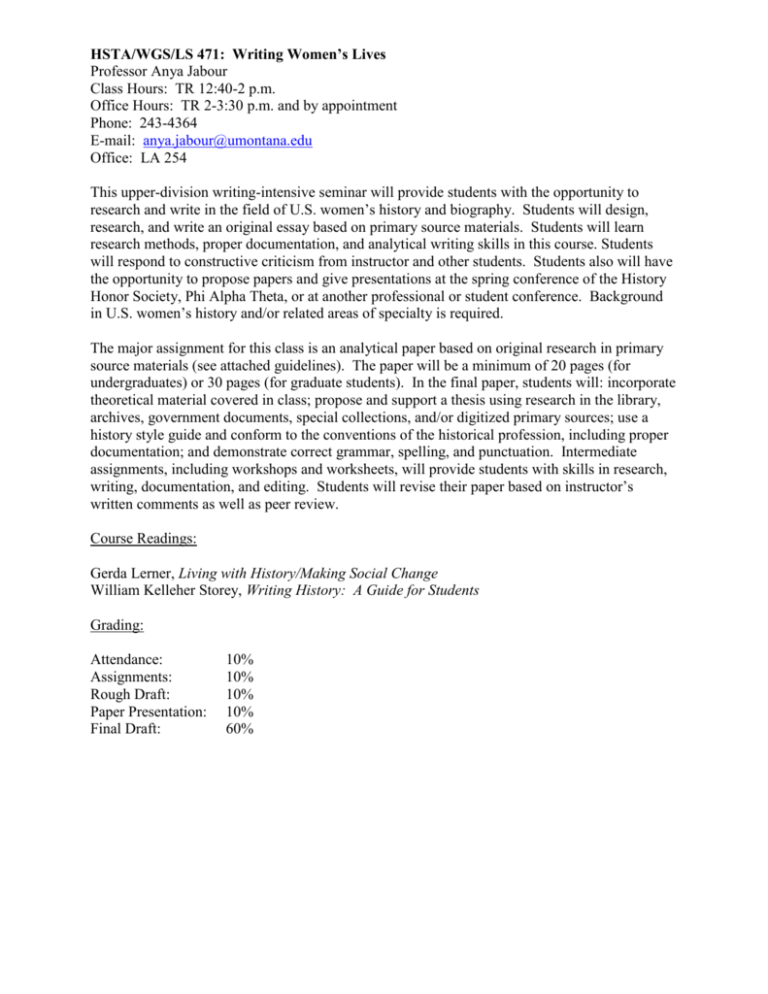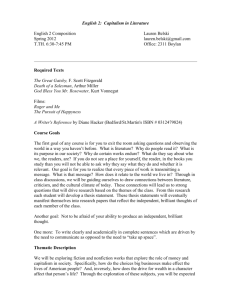HSTA/WGS 470: Writing Women`s Lives
advertisement

HSTA/WGS/LS 471: Writing Women’s Lives Professor Anya Jabour Class Hours: TR 12:40-2 p.m. Office Hours: TR 2-3:30 p.m. and by appointment Phone: 243-4364 E-mail: anya.jabour@umontana.edu Office: LA 254 This upper-division writing-intensive seminar will provide students with the opportunity to research and write in the field of U.S. women’s history and biography. Students will design, research, and write an original essay based on primary source materials. Students will learn research methods, proper documentation, and analytical writing skills in this course. Students will respond to constructive criticism from instructor and other students. Students also will have the opportunity to propose papers and give presentations at the spring conference of the History Honor Society, Phi Alpha Theta, or at another professional or student conference. Background in U.S. women’s history and/or related areas of specialty is required. The major assignment for this class is an analytical paper based on original research in primary source materials (see attached guidelines). The paper will be a minimum of 20 pages (for undergraduates) or 30 pages (for graduate students). In the final paper, students will: incorporate theoretical material covered in class; propose and support a thesis using research in the library, archives, government documents, special collections, and/or digitized primary sources; use a history style guide and conform to the conventions of the historical profession, including proper documentation; and demonstrate correct grammar, spelling, and punctuation. Intermediate assignments, including workshops and worksheets, will provide students with skills in research, writing, documentation, and editing. Students will revise their paper based on instructor’s written comments as well as peer review. Course Readings: Gerda Lerner, Living with History/Making Social Change William Kelleher Storey, Writing History: A Guide for Students Grading: Attendance: Assignments: Rough Draft: Paper Presentation: Final Draft: 10% 10% 10% 10% 60% Course Schedule: Week One: Introduction to Women’s History Week Two: The Discipline of Women’s History Reading: Lerner, Living with History, Chaps. 1 and 2 Week Three: The Theory of Women’s History Reading: Lerner, Living with History, Chap. 10; Joan Scott, “Gender: A Useful Category of Analysis”; Joan Kelly, “U.S. Women’s History” (On Reserve) Week Four: The Practice of Women’s History Film: A Midwife’s Tale Week Five: The Forms of Women’s History Readings: Lerner, Living with History, Chaps. 8 and 9 Week Six: The Research of Women’s History, Part 1 Workshop: Using the Library Assignment: Secondary Source Worksheet (10 points) Week Seven: The Research of Women’s History, Part 2 Workshop: Using the Archives and Special Collections Assignment: Archives and Special Collections Worksheet (10 points) Week Eight: The Research of Women’s History, Part 3 Workshop: Using Local Records Assignment: Local Records Worksheet (10 points) Week Nine: The Writing of Women’s History, Part 1: Defining a Topic Individual Meetings. Sign up for a slot on my office door. In preparation for the meeting, review the list of potential topics and come prepared to suggest a topic for your final paper. Missing your meeting will count as an absence; arriving unprepared will count as one-half absence. Reading: Storey, Writing History, Chap. 1 Assignment: Paper Proposal (20 points). Paper proposals should define the topic, pose a question that the paper will attempt to answer, and explain what primary sources you will use. Head your proposal with a title and subtitle that indicate your topic (including the place and time period) and the direction of your paper. Week Ten: The Writing of Women’s History, Part 2: Using Sources Reading: Storey, Writing History, Chaps. 2, 3, and 4 Workshop: Documenting Your Discoveries Footnote Worksheet (10 points) Assignment: Bibliography (20 points) Your bibliography should list at least five secondary sources (books and articles) as well as your primary sources (archival collections, maps, government documents, photographs, etc.) in proper format. Week Eleven: The Writing of Women’s History, Part 3: Organization and Argument Reading: Storey, Writing History, Chaps. 5-9 Workshop: Paragraph and Sentence Structure Assignment: Paper Outline (20 points) Your paper outline should provide the following information about your paper: title (with subtitle if relevant); thesis (one or two sentences maximum), and outline of your paper’s organizational structure. Week Twelve: The Writing of Women’s History, Part 4: Re/Writing Reading: Storey, Writing History, Chap. 10 Workshop: Rough Draft Critiques (10 points) Assignment: Rough Draft Week Thirteen: The Writing of Women’s History, Part 5: From Rough to Final Draft Individual Meetings. Sign up for a slot on my office door. Bring a copy of your (revised) rough draft and be prepared to discuss further revisions. Missing a scheduled meeting will count as an absence; arriving unprepared will count as one-half absence. Assignment: Response to Critiques (10 points) Summarize the changes you plan to make in response to your readers’ critiques. List the steps you will need to take to improve your paper: reorganize using new outline; consult additional secondary/primary sources; expand discussion of point(s), etc. Week Fourteen: The Presentation of Women’s History Assignment: Paper Presentations Week Fifteen: Reflections on Women’s History Final Paper Due HSTA/LS/WGS 470: Writing Women’s Lives Final Paper Guidelines and Assignments 1. The first step in writing your final paper or designing your final project is to define your topic and locate your sources. These are related goals since you will not be able to pursue a topic for which you cannot find sufficient source material. Each of you should meet with me to discuss your ideas for the paper and get individual help. The purpose of this meeting will be to help you to design a prospectus and bibliography. In this assignment, you should define your topic and focus. For example: My topic is western women. My focus is western women’s domestic labor. You should also locate your most important sources. The single most important source is the body of primary (first-hand) historical material, such as oral histories, diaries, letters, newspaper accounts, etc. In this assignment, you should identify your principal primary source. For example: My major primary source will be Janet Lecompte, ed., Emily, the Diary of a Hard-Worked Woman. Finally, your prospectus should include a tentative bibliography or list of sources (I will be happy to help you get started on this). You should divide your bibliography into primary and secondary source materials, and you should provide complete publishing information (author, title, publishing place and house, date) for each source. In this assignment I will be evaluating the following: choice of topic and clarity of focus; appropriateness of primary source(s); feasibility of proposed paper/project; and list of secondary sources. 2. The next stage, after completing a satisfactory prospectus and bibliography, is for you to do your research. You should begin your research immediately after spring break, if not sooner. However, your next assignments have to do with initial presentations of your research. This will take two forms: oral and written. The written portion is the rough draft. You should expect to write several drafts, and you may hand in as many rough drafts as you like prior to the deadline for a rough draft if you want additional feedback. The required rough draft should not be a first draft! For the rough draft, I will evaluate: graceful introduction and conclusion; clear thesis statement in introduction; follow-through of thesis throughout paper via topic sentences and closing sentences for each paragraph; use of primary sources; and use of secondary sources. I will also alert you to problems such as an overly ambitious topic, poor grammar or spelling, unclear organization, and inadequate documentation. 3. The oral segment is the class presentation of your research. This consists of a 10-minute discussion of your major questions (what you wanted to find out), your research process (how you went about researching the topic), and your conclusions (what you found). The class presentation is an opportunity for you to share your findings with the group and to get constructive criticism from your classmates. Thus, while I will evaluate your presentation, this assignment also requires each of you to evaluate your peers. In both my evaluations and peer evaluations, the primary criteria will be: the material of the presentation (what does the presenter have to tell us? is s/he well-informed on her/his chosen subject?); the clarity of the presentation (is the argument clear? is the evidence clearly organized?); and the style of the presentation (is the speaker prepared? does s/he present the information is a coherent fashion? does s/he stick to the time allotment for the presentation?). 4. The final assignment is the final paper. In addition to the assigned book on Writing History, I also recommend that you consult The Chicago Manual of Style and Strunk and White's Elements of Style. An organizational guide is also attached for your reference. On the final paper, I will evaluate: introduction and conclusion; thesis statement and follow-through; organization and transitions; use of primary sources; use of secondary sources; grammar; proofreading; documentation; and writing style. I will expect all final written assignments to be presented in a professional manner, by which I mean clearly typed or laser-quality printed on clean paper, stapled or otherwise collected, and complete with your name and the title of the paper. Pages should be numbered. Research Paper Structure Introduction Generalizations/thesis statement Brief rehearsal of paper’s main points/contribution Thesis statement Historiography Other scholars’ interpretations Your contribution Methodology/Sources Sources (type, place, time period, etc.) Nature of sources (potential flaws, usefulness, etc.) Body of Paper (remaining paragraphs should each follow this formula) Transition sentence/phrase (when necessary to smooth shift in topic) Topic sentence (what is the point of the paragraph?) Evidence (provide exact citations for all material, not just quotes!) Analysis of evidence (how does it demonstrate the topic sentence) Connection to thesis (how does the topic sentence relate to the thesis statement) Conclusion Restatement of thesis statement Summary of body of paper So what? (why should we care?)







